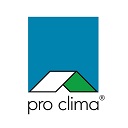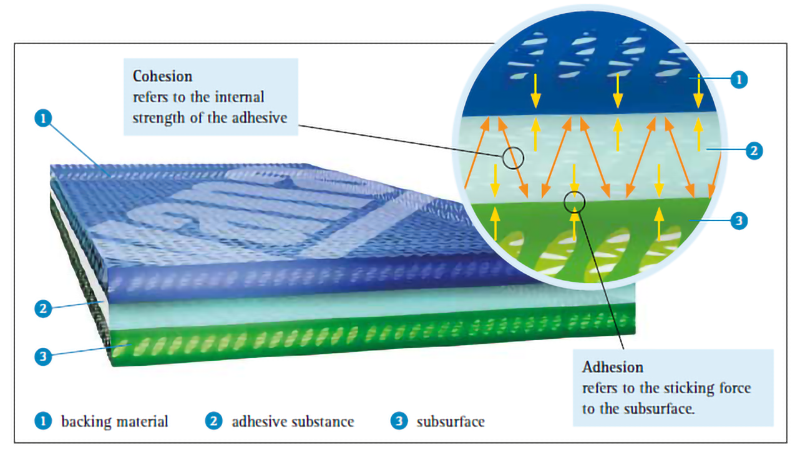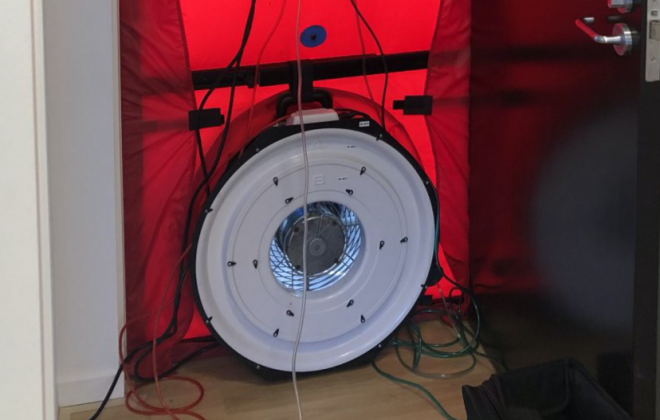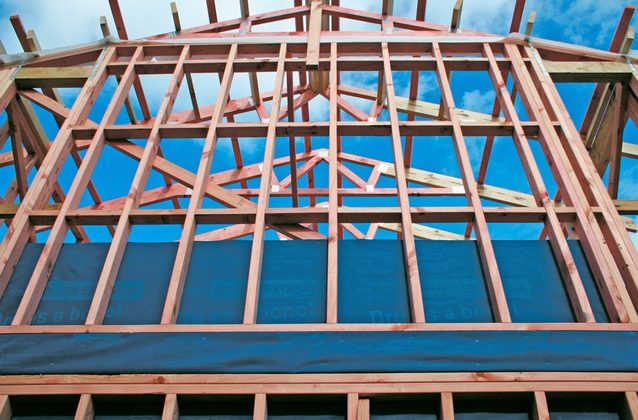Why Do Adhesives Stick?

Adhesive tapes: how do they work, what should they be able to do, and what can they do?
Adhesive tapes are used as bonding aids in a wide range of applications in the creation of airtight building envelopes. Several hundred meters of tape is often used in a single building! Adhesive tapes have become established as bonding agents for these applications (just as nails are the standard solution for timber structures). They have to fulfill their functions for a number of decades to ensure that the building in question fulfills the standards expected by the energy consultant and by the building client. This article provides an overview of adhesive technology and the key properties of adhesive tapes typically used in construction
Aren’t all adhesive tapes the same?
Adhesive tapes might appear similar or even identical at first glance: when you compare different products, they all have a backing material. Depending on the planned application for the adhesive tape in question, this backing material may consist of paper, plastic film, or fleece. An adhesive substance has been applied to the backing, and this adhesive substance is covered by a protective sheet or protective paper on the underside of the tape. The various types of backing facilitate different areas of application. For example, a tape that can be used both indoors and outdoors must have a UV-stabilised backing; an adhesive window-sealing tape must have a fleece backing that can be plastered over. The difference is easy to recognise. However, if you consider the adhesive substance itself, the difference is not so easy to identify. A review of datasheets is often of little help in this regard, as they generally only specify limited technical data – and this data is also difficult to compare.
Adhesive tapes for the creation of airtightness are generally manufactured using two main production methods. The majority (around 80 – 85%) are produced as dispersion adhesives. In this process, acrylates dissolved in water are applied to the backing material in liquid state. Emulsifiers are added to the dispersion to ensure that the dispersion remains homogeneous and that the acrylates dissolve in water in the first place. The function of these emulsifiers is to attract water. The water is then evaporated in long drying tunnels later in the production process. The dissolved
acrylates bond with one another, form long chains of molecules, and become »sticky« as a result. The emulsifiers remain in the adhesive film, but no longer serve any purpose. A more exclusive group of adhesive tapes is manufactured using a solids-based adhesive containing pure acrylate. This production technology is relatively new and more laborious from an engineering viewpoint compared to the process used for adhesive tapes with acrylate dispersions. The adhesive is applied to the backing material in the form of a viscous mass and the individual acrylate molecules are cross-linked by the controlled addition of energy in such a way that the desired adhesive properties are created.
Honey and stone, or adhesion and cohesion
Adhesion and cohesion can be demonstrated very well by comparing runny honey with a stone. Honey exhibits good adhesion and sticks to surfaces very well as a result. However, its inner strength (cohesion) is so bad that it runs off in drops under the action of its own weight. A stone has high inner strength, i.e. cohesion, but very low adhesion. Good adhesion is generally associated
with poor cohesion and vice versa. A good adhesive tape results from an ideal balance between cohesion and adhesion.

Why do adhesives stick? Sloths, squirrels and geckos
Let us consider the interesting question of how and why adhesive tape is able to stick things together. The bond with the substrate is achieved using various mechanisms. Sheeting or a pane of glass may appear smooth at first glance, but their surfaces actually look very different – with hills and valleys – when viewed under magnification. The adhesive flows around these structures and claws to the surface like a squirrel on a tree or grips the surface like a sloth wrapped around a branch. If the adhesive is in direct contact with the surface, attractive forces – so-called Van der Waals forces – will result between the two elements at a molecular level. The closer the adhesive comes to the surface, the more these forces will come into play and increase the strength of adhesion to the substrate. A similar principle applies with the gecko, which is able to walk upside-down on smooth surfaces such as panes of glass. This is made possible by the large number of very fine setae (hairs) on the feet of geckos, which increase the contact surface and thus facilitate sufficiently strong adhesive forces.
Take your time: the build-up of adhesive force
It can take some time before an adhesive has flowed into a subsurface fully and established a strong bond with it. Adhesive strength is generally built up over a period of hours. The reason that all manufacturers recommend that their adhesive tapes should be pressed into place can be explained by the mechanisms described above: an adhesive must be brought into close contact with a subsurface to be able to flow around and surround it.
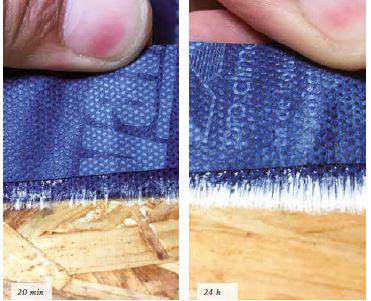
A drop of water brings clarity – The influence of surface tension
There is a commonly held myth that an adhesive should be able to stick to every surface. And if an adhesive bond doesn’t hold as desired, then it’s always the adhesive agent’s fault! However, this assumption is false. Nobody would think of taking two pieces of firewood, applying wood glue to them, pressing them together briefly and then pulling them apart again immediately, and then saying that the glue was responsible for the fact that the bond didn’t hold. The quality of a given bond is always dependent on the bonding agent, the subsurface and the method of applying the bond. The release films used are evidence that not all membranes are suitable for adhesion: some adhesive tapes can be easily removed from their release films. On the other hand, there are films that tapes bond well to, but which then become detached under tension. Finally, there are also films that adhesive tapes cannot be removed from at all. The surface tension of membranes is responsible for all of this. This tension describes how well a given membrane can be ‘wetted’ by an adhesive – in other words, how well the adhesive can get close to the surface of the membrane to be stuck. The surface tension of a membrane cannot be seen, and this value is specified in datasheets by a few limited number of manufacturers.

Water drop test
How can one estimate surface tension on a construction site? One possible method here is the water drop test: a drop of water is placed on the surface of the membrane and it is observed how well the drop of water spontane-ously wets the surface. The greater the surface tension (surface energy) of the membrane, the greater the likelihood that the water drop will be pulled out of its »drop« shape. This indicates a stronger and more reliable adhesive bonds with an airtight membrane. Of course, this test does not provide precise information, but it has proven useful in practice over a
long period. Membranes with a surface tension of > 40 N/mm are recommended for permanent airtight adhesive bonds. Membranes with surface tensions significantly below this value are often
used in building practice. In order to supply the market with adhesive tapes that can still stick to these lower quality surfaces, large quantities of resins are added to acrylate dispersion adhesive
tapes, in particular. These resins stick aggressively to poor surfaces. However, the problem here is that resins can oxidise with oxygen, become brittle over their service lives and lose their adhesive strength. To prevent this happening, it is recommended to ensure that adhesive tapes that only contain pure acrylates are selected. As well as being used for adhesive bonds for membrane overlaps, acrylate adhesive tapes can also be used on joints to adjacent building components consisting of timber, stone, wood fibreboards, plaster and concrete. This is possible as long as the surface is generally even, free of dust and resistant to abrasion. If all three of these prerequisites are not fulfilled by a given surface, it can be pre-treated with a primer. Primers for acrylate tapes are applied in liquid form and differ from undercoats in terms of their mechanism. An under-coat penetrates deep into the surface and strengthens it. A primer for an acrylate adhesive tape is designed to penetrate into the subsurface and also to form a film on the surface that levels out any unevenness. These primers have proven themselves in practice. It is critical that the primer is suitable for the adhesive tape: i.e. one should always think in terms of overall systems.

Resistance to moisture – why are there differences?
Nobody wants moisture on a building site, but regrettably the reality often very different! Adhesive tapes have to be able to reliably withstand the challenges of moisture after they are installed. The first protective layer is the backing material that is used. A film is clearly more resistant to water than paper. However, moisture does not always come only from the outside, but often from the
subsurface too. In this case, the advantage of the external protective effect of the film is reversed, as the moisture cannot escape through the film and builds up instead between the adhesive and the film. As already described, acrylate dispersion adhesives contain emulsifiers in their adhesive film after production. A characteristic of emulsifiers is that they store water, and they are still capable of doing this years later. If an acrylate dispersion adhesive comes into contact with water again, the adhesive emulsifiers, often assumes a white colouring and can lose adhesive strength. Pure acrylates are fully water-resistant, as they do not react with water in this way, their adhesive strength is preserved.

See yee, who join in endless union – Durability: experience and laboratory tests
Reference is often made to the positive experience observed over the last 20 years with regard to the durability of adhesive tapes. When we plan and build a house nowadays, clients expect the built structures and the materials used to have a service life of 50 years or longer. As a result, it is even more important when selecting adhesive tapes to take into account long experience in the marketplace alongside ageing tests that confirm high durability of bonding agents.
Consistent rules: standards for bonding agents create a basis for comparison
Presently, adhesive tapes are not regulated by standards in Australia and New Zealand and there are no uniform minimum requirements that have to be fulfilled by products. However the recently published DIN 4108-11 2018 specifies minimum requirements for adhesives and tapes in Germany. This standard contains various tensile strength tests on standardised subsurface such as wood and membranes, as well as the possibility of having systems (membranes and adhesive tape) tested by manufacturers. Many of the requirements demanded from adhesive tapes described above are formulated in this standard. For example, the tapes are pressed into place in a defined manner before conducting a pull-off test, and the test is carried out with a low pull-off speed so as to simulate the long-acting, low tensile stresses that occur in real applications in this test. Ageing also forms part of the scope of the standard. The standard forms a good basis for comparing adhesive tapes with one another and can help installers and project planners to make informed decisions globally.

Summary: permanent adhesive joints are only possible with good systems and the right handling
Permanent adhesive joints on construction projects are feasible and can achieve reliable performance; nonetheless, damage to structures often occurs when joints become detached. Knowledge about the fundamentals of adhesion technology and about the loads that will actually be acting in practice is crucial in order to be able to carry out reliable project planning and testing too. An optimal end result can only be achieved with good handling, a high-quality subsurface and a suitable adhesive tape. All three of these criteria should be carefully considered by the specifier and the energy consultant on site.

Tags In
Authors
Recent articles
- German School Buildings Top The Class November 21, 2024
- The Perfect Pod July 24, 2024
- Above Sheathing Ventilation – Part 0: Flat Roofs September 12, 2023
- Above Sheathing Ventilation – Part 3: Fighting the Sun December 13, 2021
- Above Sheathing Ventilation – Part 2: The Blue Planet October 26, 2021
